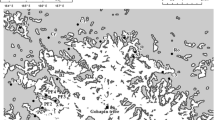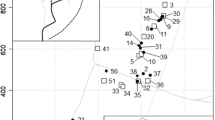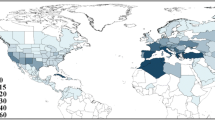Abstract
Ants of the genus Pheidole are abundant and hyperdiverse, particularly in Neotropical rainforests. Very little is known, however, about the degree of ecological and behavioral differentiation of coexisting species comprising Pheidole communities. Additionally, the ecological role of the major worker subcaste, thought to be significant to the diversification of Pheidole, is poorly understood. We investigated the ecology and behavior of a ground-foraging Pheidole community of at least 56 species in Amazonian Ecuador. Pheidole species differed strongly in tolerance to flooding, nest site usage, foraging range, major worker foraging, and control of baits, but not in daily activity or ability to discover baits. A molecular phylogeny based on mitochondrial DNA was characterized by poorly resolved basal relationships and long terminal branches, suggesting an ancient diversification of many Pheidole lineages. Comparison of well-supported sister species suggests that both phylogenetic history and ecologically induced differentiation contribute to interspecific variation in Amazonian Pheidole. Ground-nesting species had larger major workers than twig-nesting species, whereas dominant species with stronger recruitment had a higher proportional abundance of major workers at baits. Variation among species suggests the presence of behavioral groups within the Amazonian Pheidole community that appear to segregate according to nest site usage and/or tolerance to flooding disturbance. Our results suggest an important role for major worker differentiation in the diversification of Pheidole.

Similar content being viewed by others
References
Adis J. 1997. Survival strategies of terrestrial invertebrates in central Amazonian inundation forests: A response to long-term flooding. Acta amazon. 27: 43-54
Andersen A.N. 2008. Not enough niches: Non-equilibrial processes promoting species coexistence in diverse ant communities. Austral Ecol. 33: 211-220
Benjamini Y. and Hochberg Y. 1995. Controlling the false discovery rate: A practical and powerful approach to multiple testing. J. R. Stat. Soc. Ser. B. 57: 289-300
Bestelmeyer B.T. 2000. The trade-off between thermal tolerance and behavioural dominance in a subtropical South American ant community. J. Anim. Ecol. 69: 998-1009
Brose U., Martinez N.D. and Williams R.J. 2003. Estimating species richness: Sensitivity to sample coverage and insensitivity to spatial patterns. Ecology 84: 2364-2377
Brown J.J. and Traniello J.F.A. 1998. Regulation of brood-care behavior in the dimorphic castes of the ant Pheidole morrisi (Hymenoptera: Formicidae): Effects of caste ratio, colony size, and colony needs. J. Insect Behav. 11: 209-219
Burnham K.P. and Overton W.S. 1979. Robust estimation of population size when capture probabilities vary among animals. Ecology 60: 927-936
Byrne M.M. 1994. Ecology of twig-dwelling ants in a wet lowland tropical forest. Biotropica 26: 61-72
Chiotis M., Jermiin L.S. and Crozier R.H. 2000. A molecular framework for the phylogeny of the ant subfamily Dolichoderinae. Mol. Phylogenet. Evol. 17: 108-116
Clarke K.R. 1993. Nonparametric multivariate analysis of changes in community structure. Austral Ecol. 18: 117-143
Colwell R.K. 2005. EstimateS: Statistical Estimation of Species Richness and Shared Species from Samples. 7.5 edn
Davidson D.W. 1998. Resource discovery versus resource domination in ants: A functional mechanism for breaking the trade-off. Ecol. Entomol. 23: 484-490
Delsinne T. Roisin Y. and Leponce M. 2007. Spatial and temporal foraging overlaps in a Chacoan ground-foraging ant assemblage. J. Arid Environ. 71: 29-44
Detrain C. 1990. Field study on foraging by the polymorphic ant species, Pheidole pallidula. Insect. Soc. 37: 315-332
Droual R. 1983. The organization of nest evacuation in Pheidole desertorum Wheeler and P. hyatti Emery (Hymenoptera: Formicidae). Behav. Ecol. Sociobiol. 12: 203-208
Felsenstein J. 1985. Phylogenies and the comparative method. Am. Nat. 125: 1-15
Fowler H.G. 1984. Recruitment, group retrieval and major worker behavior in Pheidole oxyops. Rev. Bras. Biol. 44: 21-24
Fowler H.G. 1993. Relative representation of Pheidole (Hymenoptera: Formicidae) in local ground ant assemblages of the Americas. Anales Biol. 19: 29-37
Gordon D.M. 1992. How colony growth affects forager intrusion between neighboring harvester ant colonies Behav. Ecol. Sociobiol. 31: 417-427
Gotelli N.J. and Ellison A.M. 2004. A Primer of Ecological Statistics. Sinauer Associates, Inc. Sunderland, MA. 510 pp
Hammer Ø., Harper D.A.T. and Ryan P.D. 2001. PAST: Paleological Statistics Software Package for Education and Data Analysis. Palaeontologia Electronica 4: 9 pp
Harvey P.H. and Pagel M.D. 1991. The Comparative Method in Evolutionary Biology. Oxford University Press, Oxford, UK. 239 pp
Hölldobler B. and Möglich M. 1980. The foraging system of Pheidole militicida (Hymenoptera: Formicidae). Insect. Soc. 27: 237-264
Huelsenbeck J.P. and Ronquist F. 2001. MRBAYES: Bayesian inference of phylogenetic trees. Bioinformatics 17: 754-755
Kaspari M. 1996a. Testing resource-based models of patchiness in four Neotropical litter ant assemblages. Oikos 76: 443
Kaspari M. 1996b. Worker size and seed size selection by harvester ants in a Neotropical forest. Oecologia 105: 397-404
Kaspari M. and Vargo E. 1995. Does colony size buffer environmental variation? Bergmann’s rule and social insects. Am. Nat. 145: 610-632
Kaspari M., Yuan M. and Alonso L. 2003. Spatial grain and the causes of regional diversity gradients in ants. Am. Nat. 161: 459-477
King J.R., Andersen A.N. and Cutter A.D. 1998. Ants as bioindicators of habitat disturbance: Validation of the functional group model for Australia’s humid tropics. Biodivers. Conserv. 7: 1627-1638
Levey D.J. and Byrne M.M. 1993. Complex ant–plant interactions: Rain-forest ants as secondary dispersers and post-dispersal seed predators. Ecology 74: 1802-1812
Levings S.C. and Franks N.R. 1982. Patterns of nested dispersion in a tropical ground ant community. Ecology 63: 338-344
Longino J.T., Coddington J. and Colwell R.K. 2002. The ant fauna of a tropical rain forest: Estimating species richness three different ways. Ecology 83: 689-702
Mertl A.L., Ryder Wilkie K.T. and Traniello J.F.A. 2009. Impact of flooding on the species richness, density and composition of Amazonian litter-nesting ants. Biotropica 41: 633-641
Mertl A.L. and Traniello J.F.A. 2009. Behavioral evolution in the major worker subcaste of twig-nesting Pheidole (Hymenoptera: Formicidae): Does morphological specialization influence task plasticity? Behav. Ecol. Sociobiol. 63: 1411-1426
Moreau C.S. 2008. Unraveling the evolutionary history of the “hyperdiverse” ant genus Pheidole (Hymenoptera: Formicidae). Mol. Phylogenet. Evol. 48: 224-239
Palmer T.M. 2004. Wars of attrition: Colony size determines competitive outcomes in a guild of African acacia ants. Anim. Behav. 68: 993-1004
Patel A.D. 1990. An unusually broad behavioral repertory for a major worker in a dimorphic ant species: Pheidole morrisi (Hymenoptera, Formicidae). Psyche 97: 181-192
Pie M.R. 2007. Morphological Evolution in a Hyperdiverse Clade: The Ant Genus Pheidole. Ph.D. Dissertation. Boston University, Boston, MA. 129 pp
Pie M.R. and Traniello J.F.A. 2007. Morphological evolution in a hyperdiverse clade: The ant genus Pheidole. J. Zool. 271: 99-109
Pizo M.A. 2007. The use of seeds by a twig-dwelling ant on the floor of a tropical rain forest. Biotropica 40: 119-121
Rambaut A. 2007. Se-al: Application for creating multiple sequence alignments from nucleotide and amino acid sequences. 2.0 edn
Rasband W.S. 2007. ImageJ. U.S. National Institutes of Health, Bethesda, Maryland. 1.38 edn
Ryder Wilkie K.T., Mertl A.L. and Traniello J.F.A. 2007. Biodiversity below ground: Probing the subterranean ant fauna of Amazonia. Naturwissenschaften 94: 725-731
Ryder Wilkie K.T., Mertl A.L. and Traniello J.F.A. 2009. Diversity of ground-dwelling ants in primary and secondary forests in Amazonian Ecuador. Myrmecol. News 12: 139-147
Ryti R.T. and Case T.J. 1992. The role of neighborhood competition in the spacing and diversity of ant communities. Am. Nat. 139: 355-374
Sempo G. and Detrain C. 2004. Between-species differences of behavioural repertoire of castes in the ant genus Pheidole: A methodological artefact? Insect. Soc. 51: 48-54
Tobin J.E. 1995. Ecology and Diversity of Neotropical Rainforest Canopy Ants. Ph.D. Dissertation. Harvard University, Cambridge, MA. 149 pp
Traniello J.F.A. 1989. Foraging strategies of ants. Annu. Rev. Entomol. 34: 191-210
Wilson E.O. 1984. The relation between caste ratios and division of labor in the ant genus Pheidole (Hymenoptera: Formicidae). Behav. Ecol. Sociobiol. 16: 89-98
Wilson E.O. 1986. The organization of flood evacuation in the ant genus Pheidole (Hymenoptera: Formicidae). Insect. Soc. 33: 458-469
Wilson E.O. 2003. Pheidole in the New World: A Dominant, Hyperdiverse Ant Genus. Harvard University Press, Cambridge, MA. 794 pp
Acknowledgments
We thank the directors and staff of TBS for assistance and support in the field. We thank Clifton Meek, Megan Johnson, Brian Henry, Noah Reid, Scott Appleby, Elise Koncsek, Frank Azorsa Salazar and Wendy Mertl for assistance in the field, and Winston McDonald for laboratory assistance. We thank Dr. Kari Ryder Wilkie for specimen donations. We are very grateful to Stefan Cover for confirming Pheidole identifications and to Dr. Gary Alpert for instruction on digital imaging. We thank Dr. Marcio Pie and Jeff Tetrault for advice and assistance with sequencing methods, and Dr. Corrie Moreau for help with PCR primers. This work was funded by a National Science Foundation Graduate Research Fellowship awarded to ALM, and NSF Grant IOB 0725013 to J.T. Voucher samples were collected and transported under permit 017-IC-FA-PNY-MA issued to A.L.M. by the Ecuadorian Ministry of the Environment and this work complied with all current laws of Ecuador and the United States of America.
Author information
Authors and Affiliations
Corresponding author
Rights and permissions
About this article
Cite this article
Mertl, A.L., Sorenson, M.D. & Traniello, J.F.A. Community-level interactions and functional ecology of major workers in the hyperdiverse ground-foraging Pheidole (Hymenoptera, Formicidae) of Amazonian Ecuador. Insect. Soc. 57, 441–452 (2010). https://doi.org/10.1007/s00040-010-0102-5
Received:
Revised:
Accepted:
Published:
Issue Date:
DOI: https://doi.org/10.1007/s00040-010-0102-5




